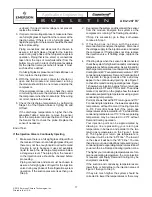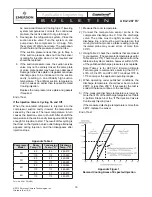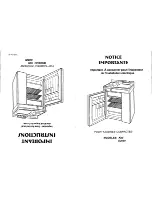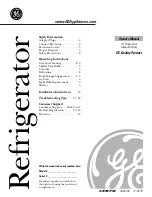
6
© 2012 Emerson Climate Technologies, Inc.
Printed in the U.S.A.
AE4-1287 R7
Application Engineering
B
U
L
L
E
T
I
N
high or low resistance reading or over temperature
condition.
The alarm relay uses a single-pole-double-throw
contact. The contact terminals are “L”, “M”, and
“A”:
“L” - Common (to “A” and “M”)
“L - M” - Normally Closed (compressor run. open
on alarm)
“L - A” - Normally Open (alarm signal, close on
alarm)
The Normally Closed (NC) contact of the alarm
relay (“L” to “M”) should be wired in the compressor
contactor control circuit so that opening this
contact removes the compressor from the line and
removes power to the CM. See
Figures 5A, B, C,
and
D
.
Figures
5A
and
B
also show a current sensing
relay
(which must be used with compressors
employing internal over current protection.
The current sensing relay is already included
when using CoreSense protection)
and Sentronic
oil pressure switch. The control circuit is purposely
arranged so that an internal overload protector trip
removes power to both the Sentronic™ and the Demand
Cooling module. This precaution prevents the oil
pressure switch from timing out and the Demand
Cooling solenoid from injecting when the compressor
is not operating.
The alarm relay requires a manual reset in order to call
attention to a system problem.
Demand Cooling
CoreSense Protection is compatible with Copeland
Demand Cooling
™
. However, the discharge temperature
protection is provided by the Demand Cooling module.
Discharge temperature information will not be
communicated to the CoreSense Protection module.
See
Figure 5E
.
System Information
1. Demand Cooling is designed to work on all
Copeland Discus
™
compressors equipped with
injection ports. A different kit is required for each
compressor body style and control voltage. See
Table 2
for a listing of Demand Cooling Kit part
numbers.
2. The system must be clean. A dirty system may
have foreign material that can lodge in the solenoid
ori
fi
ce. Always install a liquid line
fi
lter dryer in
the injection valve inlet line capable of removing
particles as small as 25 microns.
3. Do not use any
fi
lters containing materials that
can leave the
fi
lter and possibly clog the IV ori
fi
ce.
4. The liquid refrigerant supply line must be a
minimum of 3/8" and routed so it will not interfere
with compressor maintenance. Liquid refrigerant
must have suf
fi
cient subcooling at the injection
valve to prevent
fl
ashing upstream of the valve.
5. The liquid refrigerant supply line to the IV must be
supported so that it does not place stress on the
IV and IV tubing or permit excess vibration. Failure
to make this provision may result in damage to the
IV and its tubing and/or refrigerant loss.
6. A head fan must be used to help lower compressor
discharge temperatures for compressors using
HCFC-22. Contact your Application Engineer for
head fan requirements with other refrigerants.
7. Return gas temperatures must
NOT
exceed 65°F.
8. System designers are advised to review their
defrost schemes to avoid floodback to the
compressor which may occur at defrost termination
with HCFC-22, HFC-407A, HFC-407C and HFC-
407F. These refrigerants have a signi
fi
cantly
higher heat of vaporization than does CFC-502,
and if the same design parameters used with CFC-
502 are used,
fl
oodback may occur.
Demand Cooling with Discus Compressor Unloading
Demand Cooling has been approved with unloading
for 4D, 6D and 3D Copeland Discus Digital™. Demand
Cooling has NOT been approved for 3D Moduload.
Note! For Discus compressors with CoreSense
Diagnostics with the build of material (BOM)
nomenclature beginning with -ADx (e.g. 4DKNF63KL-
TSK-AD0) Demand Cooling capability is built in.
4D and 6D Unloading with Demand Cooling
Demand Cooling protection is applicable with
compressors using conventional blocked suction
unloading. Earlier application guidelines required
that liquid injection only occur when the compressor
is in its fully loaded state. This was to avoid
fl
ooding
the compressor with saturated liquid. After further
evaluation, Emerson engineering has determined
that the Copeland Discus compressor will still
fl
ash
the injected liquid refrigerant when the compressor is
unloaded should the discharge temperatures govern
the need for added cooling. The Demand Cooling




































